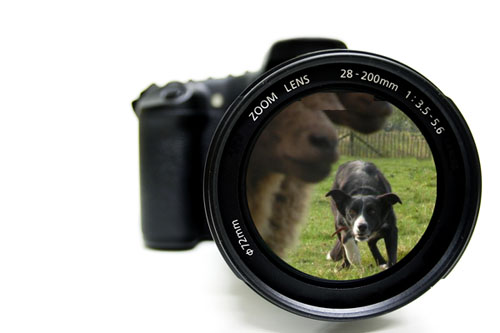



|
“PICTURE THIS”
I've always had a propensity to view dog training as "art" - along the lines of taking and developing photographs. Before you ever "click" the camera you need to have a concept in your mind of the visual rendering you are trying to create.
Each work session is equivalent to taking "snapshots" for your photo album of a finished dog ... hopefully "all the while" you are building these images into a panoramic view. The snapshots you take can never be replicated by anyone else’s but the “end product” (a dog working correctly) will still be recognized by sheep and handlers alike.
After you have enough snapshots you move on to the developing room. At the onset all you will see is a blurred image of a dog and sheep - but with work, time and patience the pictures become clearer and sharper until you have a physical entity to match the original image in your eye. "By the way" ... the key word is "develop" not Photoshop:~).
Do the snapshots you are now taking measure up to the refined image you are trying to expose. Or do your snapshots portray a dog flanking tightly, flying past balance, not stopping or listening. If “this is the case” … the picture you are endeavoring to develop will never come into view. You can't take blurred images and end up with a crisp, sharp picture. If you are only taking black and white shots you will miss out on that beautiful color portrait you see when a good open dog runs.
The key to a proficient finished dog is learning to take the correct snapshot exactly when it’s happening. Your timing will “make or break” how your dog’s portrait unfolds.
Let's say you are working on outruns and your dog tends to run tight at the top. So, in an effort to widen him out - you have been giving him a stop and then a redirect. One day it "clicks in his mind" that when he hears the stop … he's TIGHT and needs flank out. So, instead of stopping he goes wider ... which is exactly what you have been trying to communicate to him.
BUT: instead of saying “YES ... you've got it! That's what I want”! (“There by” encouraging him to problem solve). You choose to make the picture "black and white" and focus on him not stopping. However; the problem is - he wasn't thinking about stopping he was thinking ... "got it" ... go wider! So although you may have thought you were properly correcting him - you weren’t - because that was NOT his thought process. So, now instead of “developing” a dog that is confident in his ability to “figure out what you want and adjust accordingly” … the snapshot you just took is of a dog hesitant to think for himself.
That “split second” is the difference between a trainer and a great trainer. It’s not only understanding that these dogs do process, think and learn but it’s that impeccable timing that rewards him at the exact moment he was thinking correctly. Work with his mind not just his body *his mind understood what you wanted … but you were more concerned with what his body was doing*. If you give corrections in relation to what YOU are thinking instead what HE is thinking then you will never achieve a full color portrait. When you get to the developing room all your photos will be black and white or “at best” dull muted colors.
Good trainer’s snapshots are crisp, sharp, in focus with great “depth of field”. The corrections and rewards come at the most optimum time … “there by” building confidence between dog and trainer. Creating one of the most significant training tools there is … the confidence the dog acquires in his own abilities to think and find solutions to difficult situations.
So, if your finished image is of a dog thinking and working with you then you need to understand how to let it develop. If you don't spend the time to get each snapshot focused ... then you will loose that picture as if it was exposed to sunlight ... fading until you can't recognize it any longer.
However, there is good news.. A picture once developed is forever frozen ("that is" unless it's photo-shopped :~)... not so with training. You can alter your final portrait by deciding to take different snapshots to add to your photo collection. So, “picture” in your mind what you want your finished dog to look like and start timing your “snapshots” to achieve that goal.
 © 1996-2010 American
Border Collie Network.
© 1996-2010 American
Border Collie Network.
|


